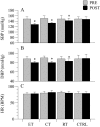Effects of endurance, circuit, and relaxing training on cardiovascular risk factors in hypertensive elderly patients
- PMID: 26381921
- PMCID: PMC5005840
- DOI: 10.1007/s11357-015-9835-4
Effects of endurance, circuit, and relaxing training on cardiovascular risk factors in hypertensive elderly patients
Abstract
Recommendations for prevention of cardiovascular diseases (CVDs) risk factors among older adults highlighted the importance of exercise-based interventions, including endurance training (ET). However, the evidence of efficacy of other interventions based on short-bouts of exercise (circuit training, CT), and the practice of breath-control and meditation (relaxing training, RT) is growing. The aim of this study was to elucidate if CT or RT are equally effective in CVD risk factors reduction compared to ET. To this purpose, in 40 elderly participants, with clinically diagnosed grade 1 hypertension, resting blood pressure, blood glucose, and cholesterol levels, peak oxygen uptake ([Formula: see text]), mechanical efficiency and quality of life were evaluated before and after 12 weeks of ET, CT, and RT treatments. Resting blood pressure reduced significantly in all groups by ∼11 %. In ET, blood cholesterol levels (-18 %), [Formula: see text] (+8 %), mechanical efficiency (+9 %), and quality of life scores (+36 %) ameliorated. In CT blood glucose levels (-11 %), [Formula: see text] (+7 %) and quality of life scores (+35 %) were bettered. Conversely, in RT, the lower blood pressure went along only with an improvement in the mental component of quality of life (+42 %). ET and CT were both appropriate interventions to reduce CVDs risk factors, because blood pressure reduction was accompanied by decreases in blood glucose and cholesterol levels, increases in [Formula: see text], mechanical efficiency, and quality of life. Although RT influenced only blood pressure and quality of life, this approach would be an attractive alternative for old individuals unable or reluctant to carry out ET or CT.
Keywords: Aging; Blood pressure; Cardiovascular disease; Circuit training; Endurance training; Relaxing training.
Figures





Similar articles
-
The Effect of Low Volume Interval Training on Resting Blood Pressure in Pre-hypertensive Subjects: A Preliminary Study.Phys Sportsmed. 2016;44(2):177-83. doi: 10.1080/00913847.2016.1159501. Epub 2016 Mar 17. Phys Sportsmed. 2016. PMID: 26918846
-
Effects of aerobic training intensity on resting, exercise and post-exercise blood pressure, heart rate and heart-rate variability.J Hum Hypertens. 2010 Mar;24(3):175-82. doi: 10.1038/jhh.2009.51. Epub 2009 Jun 25. J Hum Hypertens. 2010. PMID: 19554028 Clinical Trial.
-
Exercise is good for your blood pressure: effects of endurance training and resistance training.Clin Exp Pharmacol Physiol. 2006 Sep;33(9):853-6. doi: 10.1111/j.1440-1681.2006.04453.x. Clin Exp Pharmacol Physiol. 2006. PMID: 16922820
-
American College of Sports Medicine. Position Stand. Physical activity, physical fitness, and hypertension.Med Sci Sports Exerc. 1993 Oct;25(10):i-x. Med Sci Sports Exerc. 1993. PMID: 8231750 Review.
-
Exercise interventions in polypathological aging patients that coexist with diabetes mellitus: improving functional status and quality of life.Age (Dordr). 2015 Jun;37(3):64. doi: 10.1007/s11357-015-9800-2. Epub 2015 Jun 9. Age (Dordr). 2015. PMID: 26054595 Free PMC article. Review.
Cited by
-
The role of physical activity in mitigating age-related changes in the neuromuscular control of gait.NPJ Aging. 2025 Jun 9;11(1):49. doi: 10.1038/s41514-025-00239-8. NPJ Aging. 2025. PMID: 40490469 Free PMC article.
-
Tailored Exercise Intervention in Metabolic Syndrome: Cardiometabolic Improvements Beyond Weight Loss and Diet-A Prospective Observational Study.Nutrients. 2025 Feb 28;17(5):872. doi: 10.3390/nu17050872. Nutrients. 2025. PMID: 40077741 Free PMC article.
-
The effects of circuit-based resistance training on blood pressure, arterial stiffness, and body composition in community-dwelling older adults: a systematic review and meta-analysis.Front Physiol. 2025 May 20;16:1609013. doi: 10.3389/fphys.2025.1609013. eCollection 2025. Front Physiol. 2025. PMID: 40464000 Free PMC article.
-
Effects of Different Inspiratory Muscle Training Protocols on Exercise Capacity, Respiratory Muscle Strength, and Health-Related Quality of Life in Patients with Hypertension.Int J Clin Pract. 2024 Feb 3;2024:4136457. doi: 10.1155/2024/4136457. eCollection 2024. Int J Clin Pract. 2024. PMID: 38344141 Free PMC article.
-
Effects of 12 weeks of functional training vs. Muay Thai on cardiac autonomic modulation and hemodynamic parameters in older adults: a randomized clinical trial.BMC Cardiovasc Disord. 2024 Aug 17;24(1):433. doi: 10.1186/s12872-024-04096-3. BMC Cardiovasc Disord. 2024. PMID: 39153977 Free PMC article. Clinical Trial.
References
-
- Aronow WS, Fleg JL, Pepine CJ, Artinian NT, Bakris G, Brown AS, Ferdinand KC, Forciea MA, Frishman WH, Jaigobin C, Kostis JB, Mancia G, Oparil S, Ortiz E, Reisin E, Rich MW, Schocken DD, Weber MA, Wesley DJ, Harrington RA, Force AT. ACCF/AHA 2011 expert consensus document on hypertension in the elderly: a report of the American College of Cardiology Foundation Task Force on Clinical Expert Consensus Documents. Circulation. 2011;123(21):2434–2506. doi: 10.1161/CIR.0b013e31821daaf6. - DOI - PubMed
-
- Astrand P-O. Textbook of work physiology: physiological bases of exercise. Champaign: Human Kinetics; 2003.
-
- Blanco-Rivero J, Roque FR, Sastre E, Caracuel L, Couto GK, Avendano MS, Paula SM, Rossoni LV, Salaices M, Balfagon G. Aerobic exercise training increases neuronal nitric oxide release and bioavailability and decreases noradrenaline release in mesenteric artery from spontaneously hypertensive rats. J Hypertens. 2013;31(5):916–926. doi: 10.1097/HJH.0b013e32835f749c. - DOI - PubMed
Publication types
MeSH terms
LinkOut - more resources
Full Text Sources
Other Literature Sources
Medical
